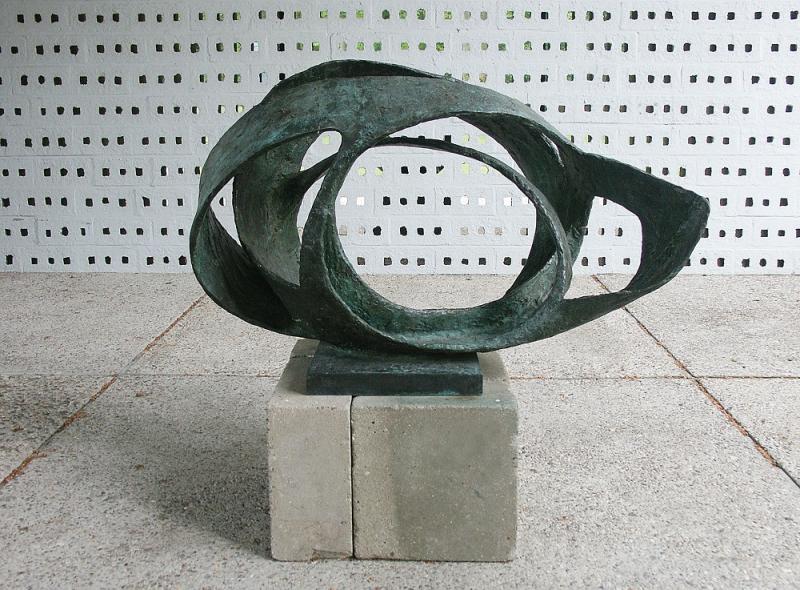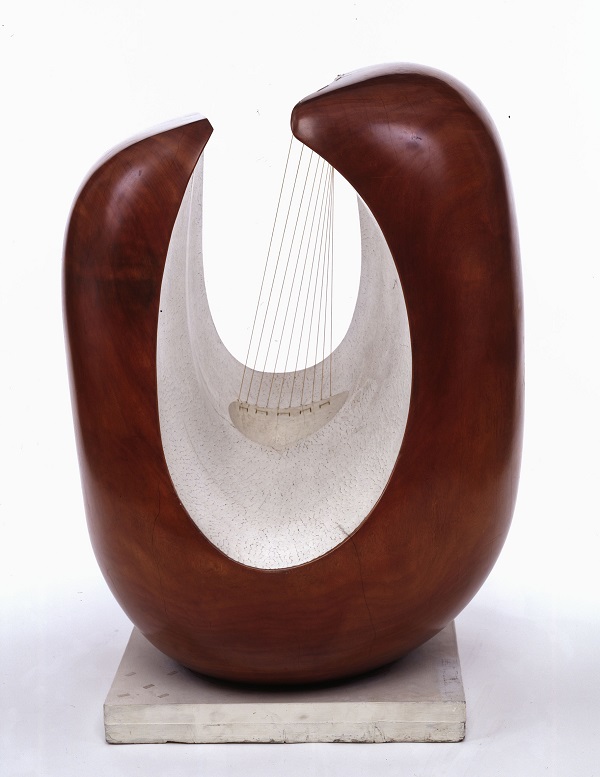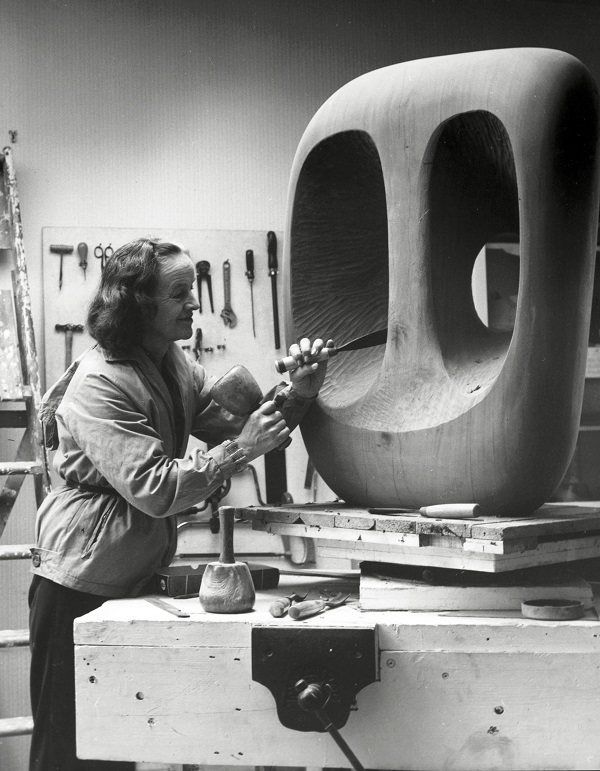Barbara Hepworth, Tate Britain | reviews, news & interviews
Barbara Hepworth, Tate Britain
Barbara Hepworth, Tate Britain
Long-awaited retrospective liberates the sculptor from Henry Moore association

One of the earliest surviving sculptures by Barbara Hepworth is a toad made from a khaki-coloured, translucent stone; you can imagine it cool and heavy in your hand, not so very different from the animal itself, in fact. Made nearly 30 years later, the monumental sculptures carved from African guarea wood are almost unbearably touchable, each one with its dark, glossy exterior cracked open to reveal an inside as creamy as a conker.
This almost synesthetic quality stems from her understanding of how materials can actively develop a subject or idea to generate a richly sensual experience. In increasingly abstract pieces, she manipulates our perception of mass, so that wood can seem as flimsy as paper, marble as soft as a marshmallow. She harnesses light, directing and focusing it like any other material at her disposal so that the shallow, circular indentation on Two Forms, 1935, seems to yield and deepen as we move around it.
It is through an appreciation of the properties of her materials, combined with a grasp of volume, mass and texture, that Hepworth is able to conflate them visually, as is demonstrated in a well-judged display of pieces from the 1930s. The white marble of Three Forms, 1935, and the dark wood of Discs in Echelon, 1935, are as uniform as a chess set. The point is perhaps unwittingly emphasised by poor lighting and thick Perspex cases, but even so, it is only by looking closely that the wood grain becomes visible, adding movement and vigour to forms that borrow the monumental solidity of their marble neighbours. (Pictured below: Curved Form (Delphi), 1955; © The Estate of Barbara Hepworth)
 Hepworth was only too aware that materials had wider connotations that could influence the way that she and her work were received, and the first room explores the considerable baggage that came with the ancient technique of “direct carving”. Bypassing the academic tradition of producing a clay model from which a finished piece was made, often by a technician expert in marble carving or bronze founding, direct carving into wood or stone instead allowed a sculptor to execute a piece of work from start to finish. The practise had been revived by Henri Gaudier-Brzeska and Jacob Epstein in the period before the First World War, and by continuing it into the next generation, Henry Moore and Barbara Hepworth became – irrevocably it seemed – bound together as lone torchbearers of the avant-garde, forging a new approach to sculpture that looked to non-European and pre-classical precedents.
Hepworth was only too aware that materials had wider connotations that could influence the way that she and her work were received, and the first room explores the considerable baggage that came with the ancient technique of “direct carving”. Bypassing the academic tradition of producing a clay model from which a finished piece was made, often by a technician expert in marble carving or bronze founding, direct carving into wood or stone instead allowed a sculptor to execute a piece of work from start to finish. The practise had been revived by Henri Gaudier-Brzeska and Jacob Epstein in the period before the First World War, and by continuing it into the next generation, Henry Moore and Barbara Hepworth became – irrevocably it seemed – bound together as lone torchbearers of the avant-garde, forging a new approach to sculpture that looked to non-European and pre-classical precedents.
An array of sculpted birds, animals and figures suggests that, in fact, quite a number of sculptors were practising direct carving in the 1920s, and this persuasive display surely takes an important step towards loosening the ties that bind Hepworth to Moore. Indeed, under the influence of the Arts and Crafts Movement, the technique was apparently taught routinely in art schools at the turn of the 20th century, alongside traditional modelling in clay. Although wood was at last beginning to be seen as a material suited to the lofty aspirations of sculptors, wood carving had become increasingly popular as an amateur pastime, practised particularly by women. Wise enough to avoid being associated with a feminine, amateur handicraft, Hepworth’s earliest experiments in direct carving were executed in stone, and when she began to carve wood in 1929, her efforts were restricted, for the most part, to elevated subject matter, such as the female nude.
 We are left with a vivid impression of a woman constantly alert to the obstacles presented by her gender, and Hepworth’s interest in controlling the presentation of her own image and her work is a recurring theme throughout this exhibition. (Pictured left: the artist at work in her studio.)
We are left with a vivid impression of a woman constantly alert to the obstacles presented by her gender, and Hepworth’s interest in controlling the presentation of her own image and her work is a recurring theme throughout this exhibition. (Pictured left: the artist at work in her studio.)
What seems to have started as sheer pragmatism really took shape as an artistic strategy when she met the painter Ben Nicholson, and in the early years of their relationship they compiled albums of carefully staged photographs, through which they promoted a controlled narrative around their lives as artists. Regularly presenting their work together, they set up dialogues and fostered certain readings of their work through particular arrangements and juxtapositions.
It is no exaggeration to say that between 1932 and 1934, Nicholson and Hepworth were involved in a collaborative venture, the spirit of which is evocatively captured here. The extent of their influence on each other’s work is remarkable, with Hepworth’s use of colour arguably a result of her husband’s influence.
The question of Hepworth’s influence on Nicholson seems particularly interesting in light of an exhibition at the Dulwich Picture Gallery last year, which explored the relationship between Ben Nicholson and his first wife Winifred, revealing the extent of their artistic interdependence, and crucially, Nicholson’s huge debt to his wife.
In an exhibition that emphasises the significance of materials in Hepworth’s work, ending with a series of bronzes is an elegant gesture. Much of her late work was cast in bronze, including prestigious, international commissions like Single Form, 1961-64, for the United Nations Plaza, New York, not least because it is a robust material and easier to transport than either wood or stone. Displayed in a recreation of the Rietveld Pavilion, which was reconstructed in 1965 at the Kröller-Müller Museum at Otterlo in the Netherlands for a major exhibition of Hepworth’s work, the last room is not only a reflection of her international status, but a suitably unexpected and thought-provoking setting, too (main picture). Hepworth’s work has become associated with the wild Cornish landscape, but it seems that she was delighted by the regular, bricked backdrops, writing to the museum’s director that “the Rietveld Pavilion gives me such a sense of happiness that it is quite difficult for me to talk about it.”
Share this article
The future of Arts Journalism
You can stop theartsdesk.com closing!
We urgently need financing to survive. Our fundraising drive has thus far raised £49,000 but we need to reach £100,000 or we will be forced to close. Please contribute here: https://gofund.me/c3f6033d
And if you can forward this information to anyone who might assist, we’d be grateful.

Subscribe to theartsdesk.com
Thank you for continuing to read our work on theartsdesk.com. For unlimited access to every article in its entirety, including our archive of more than 15,000 pieces, we're asking for £5 per month or £40 per year. We feel it's a very good deal, and hope you do too.
To take a subscription now simply click here.
And if you're looking for that extra gift for a friend or family member, why not treat them to a theartsdesk.com gift subscription?
more Visual arts
 'We are bowled over!' Thank you for your messages of love and support
Much-appreciated words of commendation from readers and the cultural community
'We are bowled over!' Thank you for your messages of love and support
Much-appreciated words of commendation from readers and the cultural community
![SEX MONEY RACE RELIGION [2016] by Gilbert and George. Installation shot of Gilbert & George 21ST CENTURY PICTURES Hayward Gallery](https://theartsdesk.com/sites/default/files/styles/thumbnail/public/mastimages/Gilbert%20%26%20George_%2021ST%20CENTURY%20PICTURES.%20SEX%20MONEY%20RACE%20RELIGION%20%5B2016%5D.%20Photo_%20Mark%20Blower.%20Courtesy%20of%20the%20Gilbert%20%26%20George%20and%20the%20Hayward%20Gallery._0.jpg?itok=7tVsLyR-) Gilbert & George, 21st Century Pictures, Hayward Gallery review - brash, bright and not so beautiful
The couple's coloured photomontages shout louder than ever, causing sensory overload
Gilbert & George, 21st Century Pictures, Hayward Gallery review - brash, bright and not so beautiful
The couple's coloured photomontages shout louder than ever, causing sensory overload
 Lee Miller, Tate Britain review - an extraordinary career that remains an enigma
Fashion photographer, artist or war reporter; will the real Lee Miller please step forward?
Lee Miller, Tate Britain review - an extraordinary career that remains an enigma
Fashion photographer, artist or war reporter; will the real Lee Miller please step forward?
 Kerry James Marshall: The Histories, Royal Academy review - a triumphant celebration of blackness
Room after room of glorious paintings
Kerry James Marshall: The Histories, Royal Academy review - a triumphant celebration of blackness
Room after room of glorious paintings
 Folkestone Triennial 2025 - landscape, seascape, art lovers' escape
Locally rooted festival brings home many but not all global concerns
Folkestone Triennial 2025 - landscape, seascape, art lovers' escape
Locally rooted festival brings home many but not all global concerns
 Sir Brian Clarke (1953-2025) - a personal tribute
Remembering an artist with a gift for the transcendent
Sir Brian Clarke (1953-2025) - a personal tribute
Remembering an artist with a gift for the transcendent
 Emily Kam Kngwarray, Tate Modern review - glimpses of another world
Pictures that are an affirmation of belonging
Emily Kam Kngwarray, Tate Modern review - glimpses of another world
Pictures that are an affirmation of belonging
 Kiefer / Van Gogh, Royal Academy review - a pairing of opposites
Small scale intensity meets large scale melodrama
Kiefer / Van Gogh, Royal Academy review - a pairing of opposites
Small scale intensity meets large scale melodrama
 Jenny Saville: The Anatomy of Painting, National Portrait Gallery review - a protégé losing her way
A brilliant painter in search of a worthwhile subject
Jenny Saville: The Anatomy of Painting, National Portrait Gallery review - a protégé losing her way
A brilliant painter in search of a worthwhile subject
 Abstract Erotic, Courtauld Gallery review - sculpture that is sensuous, funny and subversive
Testing the boundaries of good taste, and winning
Abstract Erotic, Courtauld Gallery review - sculpture that is sensuous, funny and subversive
Testing the boundaries of good taste, and winning
 Edward Burra, Tate Britain review - watercolour made mainstream
Social satire with a nasty bite
Edward Burra, Tate Britain review - watercolour made mainstream
Social satire with a nasty bite
 Ithell Colquhoun, Tate Britain review - revelations of a weird and wonderful world
Emanations from the unconscious
Ithell Colquhoun, Tate Britain review - revelations of a weird and wonderful world
Emanations from the unconscious

Add comment